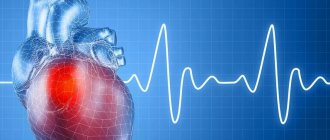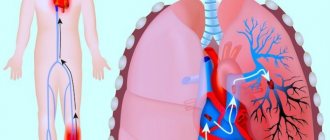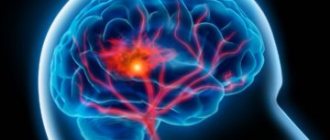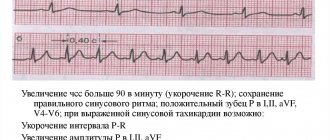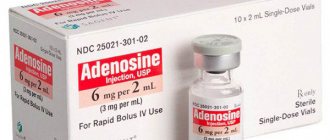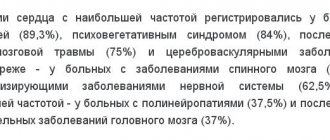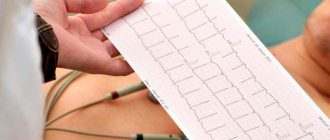The heart is a significant organ, the work of which is not yet fully understood, despite the successes and breakthroughs of modern medicine.
This is a kind of pump that pumps blood, thanks to which it circulates through the circulatory system and nourishes the entire body.
But sometimes his work fails. Let's figure out what it is - sinus arrhythmia of the heart, whether such a rhythm disturbance is dangerous and why.
general information
Sinus arrhythmia implies a malfunction of the heart when the difference between heartbeats is more than 10% (if this figure is less, there is no pathology). At the same time, the pulse remains within normal limits (60-80 beats per minute).
Sinus arrhythmia must be present in a person, since in a calm state the heart beats moderately, and in response to excitement or during physical activity, the pulse quickens. It allows you to see the level of adaptation of the heart muscle to stress and is, within certain limits, a sign of good health.
A person’s heart cannot constantly beat in the same rhythm (like a clock), this indicates the depletion of its reserve abilities.
According to statistics, arrhythmias account for 10-15% of all heart diseases . In recent years, the number of cases has been growing. Sinus arrhythmia is most often observed in older people, as well as in those who abuse alcohol or drugs.
In children, sinus arrhythmia is present quite often, but in most cases it is not a pathology, since the nervous system simply cannot keep up with the growing body.
The disease does not require treatment if it develops against the background of severe nervous experiences. As soon as a person relaxes, it goes away on its own. To calm down in this case, you can use herbal remedies (valerian, motherwort).
Symptoms of the disease, especially in the early stages, do not appear clearly. A person may not realize that he has health problems for quite a long time.
What needs to be examined
Diagnosis is carried out under the supervision of a cardiologist. This is his prerogative. As needed, specialists in endocrinology and the nervous system are involved.
An approximate list of activities is as follows:
- Interview of the patient orally with recording of complaints.
- Taking an anamnesis to establish the underlying cause of the disease process. Measurement of blood pressure, heart rate. Repeatedly.
- Daily monitoring. Allows you to evaluate both indicators (BP and heart rate), at rest and within the framework of usual physical activity. This is an informative technique.
- Electrocardiography. The most important study. It is carried out both at rest and after activity (so-called stress tests). Typically, a treadmill and bicycle ergometry are used.
- Angiography.
- CT or MRI of the heart.
- Echocardiography. Ultrasound technique.
- Blood tests (biochemistry, hormones and general).
At the discretion of specialists, other diagnostic methods are also used. As a rule, these are enough and even many.
Classification
Sinus arrhythmia is divided into the following types, determined by heart rate (HR):
- Tachyarrhythmia , in which a rapid heartbeat above 80 beats per minute is monitored;
blood does not fill the heart in full, which is why all internal organs suffer and blood flow is disrupted. Identified in people with problems with the thyroid gland and autonomic nervous system; - Sinus bradycardia – the patient’s heart rate is less than 60 beats per minute;
the cause may be fasting or a long diet, increased intracranial pressure, thyroid problems, or taking certain medications. A decrease in heart rate below 40 beats per minute can lead to fainting or even cardiac arrest and death; - Extrasystole is a premature contraction of the heart muscle that occurs due to nervous overload and stress, bad habits, and lack of magnesium and potassium in the body.
The cause may also be forms of ischemic heart disease and dystrophy of the heart muscle. Cardiac output is unproductive. The patient experiences a feeling of a sinking heart, dull tremors in the heart area, a feeling of anxiety and lack of air; - Physiological (respiratory) sinus arrhythmia is not a deviation from the norm; it manifests itself in a slowdown in heart rate during exhalation and acceleration during inhalation.
Inherent in children and adolescents, in adults sinus respiratory arrhythmia sometimes accompanies vegetative-vascular dystonia, brain diseases, and appears after severe infections.
Treatment of sinus arrhythmia
Restoring the heart rate is carried out using medicinal techniques. The operation is indicated only if conservative measures are completely ineffective. Compliance with the therapeutic and protective regime, and in some cases, limiting physical activity, is of considerable importance.
Medication
To relieve attacks of rapid heartbeat provoked by psycho-emotional reactions, sedatives are used: motherwort, Corvalol, valerian tincture. In cases of severe agitation, phenozepam and elzepam may be taken. The presence of organic changes in the heart requires antiarrhythmics: beta blockers (propranolol), glycosides (digoxin).
Moderate bradycardia is a reason to consume anticholinergics (belladonna tincture, Zelenin drops) or beta-adrenergic receptor stimulants (ephedrine, alupent).
Direct sinus arrhythmias do not require specific treatment . Treatment of the underlying disease is indicated. Physiological respiratory changes are not subject to drug correction. With SSSU, the patient receives drugs such as atropine, belloid, chimes, and isadrin. You may need to take allapinin. Sick sinus syndrome is difficult to treat. The only effective treatment method is surgery.
Surgical
Invasive manipulations for sinus arrhythmias are practically not indicated . As mentioned above, the only indication for surgical restoration of coronary rhythm is SSVR. In this case, the patient is fitted with a pacemaker - a device that takes on the function of a synatrial pacemaker. The work is carried out in an X-ray operating room; anesthesia is not used. The method of pain relief is local anesthesia. The device itself is mounted in the subcutaneous fatty tissue, and the electrodes are inserted into the cavities of the heart.
Stages
The following stages of the disease are distinguished:
- Mild (moderate) sinus arrhythmia - for the most part does not manifest itself in any way, can be a specific feature of a particular organism, and can also accompany old age.
It is not a deviation from the norm if it is associated with hormonal changes in the body (in adolescents). It is necessary to consult a doctor to determine the exact cause and nature of the disease. - Sinus arrhythmia of the first degree - symptoms occur rarely and, as a rule, go away on their own, the patient does not experience discomfort.
Often manifested in breathing disorders (respiratory arrhythmia), detected in adolescents during puberty, in athletes, and in older people. Consultation with a doctor is required, especially if frequent fainting occurs. - Sinus arrhythmia of the second degree - the symptoms are most clearly expressed and coexist with various heart diseases. A person develops severe weakness, fatigue, and shortness of breath.
- Sinus arrhythmia of the third degree - the symptoms appear very clearly.
It is extremely important to carry out timely diagnosis to identify the exact cause of the disease and prescribe treatment. There is a possibility of developing serious complications. An examination of all internal organs is required.
Severe sinus arrhythmia can be dangerous to human health and requires mandatory treatment.
Causes
In children and adolescents:
- severe stress, psychological depression;
- intrauterine developmental defects;
- tumors and heart defects;
- pathologies of internal organs;
- heredity;
- poisoning;
- long-term and severe infections;
- myocardial diseases.
Risk factors: overweight children with rickets, babies with postnatal encephalopathy, children aged 6-7, 9-10 years, when the nervous system does not keep up with growth, diseases of the thyroid gland, heart and blood vessels, rheumatism.
In young and middle-aged people:
- high blood pressure;
- heart defects;
- chronic lung and thyroid diseases;
- alcoholism and smoking;
- viral infections;
- stress;
- heart surgery;
- lack of potassium and magnesium in the body.
Risk factors: hidden heart disease, abuse of various stimulants (caffeine), taking certain medications (theophylline), obesity.
In older people , sinus arrhythmia, in addition to the above reasons, is almost always a manifestation of another heart disease, a consequence of other health problems, including age-related ones.
Risk factors may include: taking medications, rich fatty foods, abuse of coffee and cigarettes.
This helps maintain heart rate
Automaticity is ensured by a special conduction system. It is represented by atypical tissue.
Conduction system of the heart
Clusters of poorly differentiated muscle fibers are located in the thickness of the myocardium, and received their own names:
- in the posterior part of the wall of the right atrium, not far from the area of the confluence of the inferior and superior pudendal veins - the sinoatrial, sinoatrial or Kiss-Fleck node (1);
- near the atrioventricular septum of the right atrium - atrioventricular node (2);
- extending from the atrioventricular node and penetrating the thickness of the left and right ventricles - the bundle of His, the branches of His (3) and the Purkinje fibers (4).
Sinusoidal heart rhythm - normal on ECG tape
The sinoatrial node is called the first order pacemaker of cardiac activity. If the heart is healthy, then it is the electrical impulses arising in this node that determine the frequency and rhythm of the heart beat. Therefore, to answer the question: “What is a sinusoidal heart rhythm?” - you can do that.
The terms “sinusoidal”, “sinus”, “sinus rhythm of the heart” are used to characterize the normotopic repetition of contractions with an equal period of time and with an amount within the age norm.
Examples of pathological variants of heart rhythm
If there are problems in the sinoatrial node or in other parts of the conduction system, then the sinus rhythm of the heart is replaced or supplemented by one of the following pathological (ectopic) options:
- Atrial rhythm . The heart contracts at a frequency of 40-60 or 80-95 beats/min due to electrical impulses from the atrioventricular (left or right) node. If a person feels well and has no cardiovascular pathologies, the atrial rhythm is considered normal. In newborn children, such a rhythm is generally initial and normal, but if over time it does not transform into sinus rhythm, then one should look for: the presence of an accessory chord, heart and mitral valve defects, infectious pathologies of the heart wall.
- Atrioventricular rhythm . If the sinus rhythm of the heart fails, then to ensure contraction of the ventricles, partial “help” or complete replacement with impulses from the atrioventricular node is possible. In this case, the heart rate slows down to a level of 40-60 beats/min or can be accelerated. In addition to sinus node failure or sinus bradycardia, the causes of atrioventricular rhythm can be sinus arrhythmia (defined below), atrial fibrillation and flutter, and atrioventricular block.
- Ventricular (idioventricular) rhythm. Has a substitutive value of the third order. Occurs in the absence or inhibition of impulses from the sinus, atrioventricular and atrioventricular nodes. The impulses may come from: one of the branches or branches of the bundle of His, Purkinje Fibers or the septum between the stomachs. Ventricular rhythm may indicate different types of heart block, absence of atrial contractions during one or more consecutive cardiac cycles, sinus node paralysis, or a state of preagonia.
For your information. In order to be 100% sure that you have a normal sinusoidal heart rhythm, you need to do an electrocardiogram.
Symptoms and signs
Symptoms of sinus arrhythmia are associated with abnormal heart rhythms. A person complains of “fading” of the heart, shortness of breath, lack of air, dizziness, weakness and fainting ; he has panic attacks associated with feelings of fear and anxiety.
The first signs of the disease are:
- palpitations; palpitations;
- pain on the left side of the chest, radiating to the arm;
- inability to take a full breath;
- dyspnea;
- pulsation in the temporal region;
- attacks of severe weakness, dizziness, fainting;
- coldness of the extremities.
What does this mean for the heart and the body as a whole?
What does the diagnosis of sinus arrhythmia mean (sinusoidal, sinusoidal or sinus arrhythmia of the heart)? This medical term refers to an abnormal heart rhythm due to pathological changes in the functioning of the sinus node - a massive accumulation of cells that play the most important role in generating electrical impulses in the heart. Electrical energy is instantly transformed into kinetic energy, and blood is pushed into the vessels with a certain force and frequency.
The absolute norm in cardiology is considered to be a rate of 60 to 90 beats per minute.
With sinus arrhythmia, the pacemaker (sinus node) produces impulses not with uniform frequency, but with different ones. At the same time, the frequency of contractions per minute rarely goes beyond the normal range. Thus, under the influence of a large number of external factors, the functions of the entire conduction system are disrupted, and arrhythmia occurs. For reference! According to the International Classification of Diseases (ICD-10), arrhythmia is assigned code 149 - Other rhythm disturbances. Unspecified bradycardia, cardiac arrhythmias in newborns, and arrhythmias complicating abortion, pregnancy, and obstetric operations were excluded.
Diagnostics
The following methods are used to diagnose sinus arrhythmia:
- ECG (electrocardiogram) - as a paramount method;
- EPI (electrophysiological study);
- echocardiogram;
- monitoring (episodic, Holter);
- load test;
- orthostatic test;
- laboratory tests (general blood test, blood test for T3 and T4 hormones);
- determination of heart rate variability.
We figured out what sinus arrhythmia means, but here’s what it looks like on an ECG:
It is necessary to diagnose the disease as early as possible, since many diseases accompany sinus arrhythmia.
Differential diagnosis is to recognize the disease in time and prevent complications .
That is why the doctor always prescribes an ECG for rhythm disturbances and as a preventive therapeutic method, which allows recognizing pathology and works as an initial diagnostic method.
First aid
An attack can take you by surprise; it begins suddenly and ends the same way. The patient should call an ambulance.
Before the team arrives, you need to try to calm the person down, create comfortable conditions, open a window, you can give a sedative (motherwort, valerian, valocordin).
If the patient loses consciousness , you need to tilt your head back and unfasten the collar. If there is no breathing or heartbeat, it is necessary to perform artificial respiration until the ambulance arrives.
Treatment and rehabilitation
Treatment should be strictly under the supervision of a specialist . Basic techniques:
- healthy balanced diet (refusal of coffee, strong tea, alcohol, fatty and sweet foods);
- to give up smoking;
- drug treatment (sedatives, tranquilizers, antiarrhythmic drugs);
- installation of a pacemaker (for severe disease);
- surgery;
- traditional medicine (only together with the main treatment and with the permission of a doctor): treatment with asparagus, lemons, walnuts and honey, hawthorn;
- treatment with leeches.
How to treat sinus arrhythmia in each individual case is determined by the attending physician.
Rehabilitation after an attack of sinus arrhythmia consists of receiving medical care, which will be aimed at restoring the heart rhythm (drug or electrical stimulation), ensuring the most calm conditions.
The patient himself must adhere to a healthy lifestyle (balanced diet and giving up bad habits), and reasonably limit physical activity.
Learn more about what sinus arrhythmia means in the video:
Types of disorders and their characteristics on the ECG
Normal indicators are not everything
It is important to evaluate other components as well. Accordingly, groups of heterogeneous disorders can be found
Excessive rhythm regularity
Or its rigidity in other words. The heart becomes too “clumsy” and practically does not react to external stimuli.
Normally, stimuli should provoke a change in heart rate such as acceleration during physical activity, a drop in the number of beats at night during rest, melatonin production and a decrease in cortisol synthesis. In this case this is not observed.
It is quite difficult to detect the problem; doctors may take an adequate and stable rhythm as the norm or even the standard.
Prognosis, complications and consequences
The prognosis is extremely ambiguous . Physiological arrhythmia does not pose a threat to human health. In young people, the prognosis is generally favorable. For other types of disease, the development scenario is determined by the nature of the underlying disease.
Complications and consequences:
- risk of sudden cardiac arrest;
- stroke;
- heart attack;
- heart failure;
- cerebrovascular accidents;
- thromboembolism;
- coma.
Relapse prevention and prevention methods:
- positive emotions and good mood;
- avoiding stress;
- avoiding heavy stress on the heart;
- gentle treatment and the most relaxed environment;
- treatment of concomitant diseases;
- proper nutrition;
- rejection of bad habits.
Sinus arrhythmia is a serious disorder of the heart, since it is almost always a symptom of another disease . It is very important to diagnose the disease promptly and correctly and take appropriate measures. Treatment should only be carried out under the supervision of a specialist.


